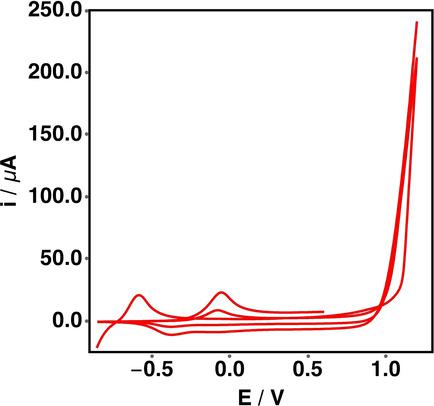当前位置:
X-MOL 学术
›
Electroanalysis
›
论文详情
Our official English website, www.x-mol.net, welcomes your
feedback! (Note: you will need to create a separate account there.)
Thin Layer Membrane Systems as Rapid Development Tool for Potentiometric Solid Contact Ion-Selective Electrodes
Electroanalysis ( IF 2.7 ) Pub Date : 2020-01-08 , DOI: 10.1002/elan.201900674 Tara Forrest 1 , Elena Zdrachek 1 , Eric Bakker 1
Electroanalysis ( IF 2.7 ) Pub Date : 2020-01-08 , DOI: 10.1002/elan.201900674 Tara Forrest 1 , Elena Zdrachek 1 , Eric Bakker 1
Affiliation

|
The use of thin membrane layer ion‐selective electrodes (of ∼200 nm thickness) as rapid diagnosis tool is proposed. While conventional solid contact systems (with a membrane of ∼250 μm thickness) may exhibit a satisfactory stability for regular laboratory use, a signal degradation can still be distinguished over a longer period of time but this requires tedious and time consuming tests. By diminishing the thickness of the membrane by a factor of 103 approximately, diffusion processes happen faster, and the lifetime is significantly reduced. This would ordinarily be a strong drawback but not if the aim is to detect a membrane deterioration in a shorter time frame. This characteristic makes thin membrane systems an ideal tool for rapid complications identification in the development process of conventional solid contact electrodes. The approach is demonstrated here in the development of an all new solid contact probe for anions. PEDOT−C14, a conducting polymer, was used for the first time in a solid contact electrode with an anion exchange membrane for the detection of nitrate. The thin layer configuration was used to optimise the polymerisation parameters as well as the membrane composition without having to run week‐long trials. A stable conventional solid contact electrode was in the end successfully developed and exhibited a lower detection limit of 10−5.5 M for nitrate with a stable Nernstian response for several days.
中文翻译:

薄层膜系统作为电位固体接触离子选择性电极的快速开发工具
建议使用薄膜层离子选择性电极(约 200 nm 厚度)作为快速诊断工具。虽然传统的固体接触系统(具有约 250 μm 厚的膜)在常规实验室使用中可能表现出令人满意的稳定性,但在更长的时间内仍然可以区分信号衰减,但这需要繁琐且耗时的测试。通过将膜的厚度减少大约 103 倍,扩散过程发生得更快,并且寿命显着缩短。这通常是一个很大的缺点,但如果目标是在更短的时间范围内检测膜退化,则不是。这一特性使薄膜系统成为传统固体接触电极开发过程中快速识别并发症的理想工具。该方法在开发用于阴离子的全新固体接触探针中得到了证明。PEDOT-C14 是一种导电聚合物,首次用于带有阴离子交换膜的固体接触电极中,用于检测硝酸盐。薄层配置用于优化聚合参数以及膜组成,而无需进行为期一周的试验。最终成功开发出稳定的常规固体接触电极,对硝酸盐的检测下限为 10-5.5 M,并在几天内具有稳定的 Nernstian 响应。薄层配置用于优化聚合参数以及膜组成,而无需进行为期一周的试验。最终成功开发出稳定的常规固体接触电极,对硝酸盐的检测下限为 10-5.5 M,并在几天内具有稳定的 Nernstian 响应。薄层配置用于优化聚合参数以及膜组成,而无需进行为期一周的试验。最终成功开发出稳定的常规固体接触电极,对硝酸盐的检测下限为 10-5.5 M,并在几天内具有稳定的能斯脱响应。
更新日期:2020-01-08
中文翻译:

薄层膜系统作为电位固体接触离子选择性电极的快速开发工具
建议使用薄膜层离子选择性电极(约 200 nm 厚度)作为快速诊断工具。虽然传统的固体接触系统(具有约 250 μm 厚的膜)在常规实验室使用中可能表现出令人满意的稳定性,但在更长的时间内仍然可以区分信号衰减,但这需要繁琐且耗时的测试。通过将膜的厚度减少大约 103 倍,扩散过程发生得更快,并且寿命显着缩短。这通常是一个很大的缺点,但如果目标是在更短的时间范围内检测膜退化,则不是。这一特性使薄膜系统成为传统固体接触电极开发过程中快速识别并发症的理想工具。该方法在开发用于阴离子的全新固体接触探针中得到了证明。PEDOT-C14 是一种导电聚合物,首次用于带有阴离子交换膜的固体接触电极中,用于检测硝酸盐。薄层配置用于优化聚合参数以及膜组成,而无需进行为期一周的试验。最终成功开发出稳定的常规固体接触电极,对硝酸盐的检测下限为 10-5.5 M,并在几天内具有稳定的 Nernstian 响应。薄层配置用于优化聚合参数以及膜组成,而无需进行为期一周的试验。最终成功开发出稳定的常规固体接触电极,对硝酸盐的检测下限为 10-5.5 M,并在几天内具有稳定的 Nernstian 响应。薄层配置用于优化聚合参数以及膜组成,而无需进行为期一周的试验。最终成功开发出稳定的常规固体接触电极,对硝酸盐的检测下限为 10-5.5 M,并在几天内具有稳定的能斯脱响应。











































 京公网安备 11010802027423号
京公网安备 11010802027423号